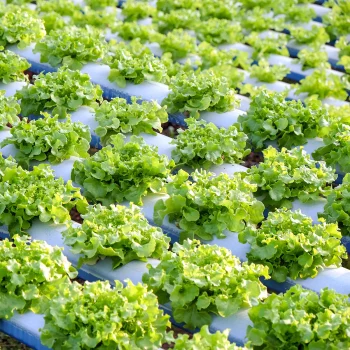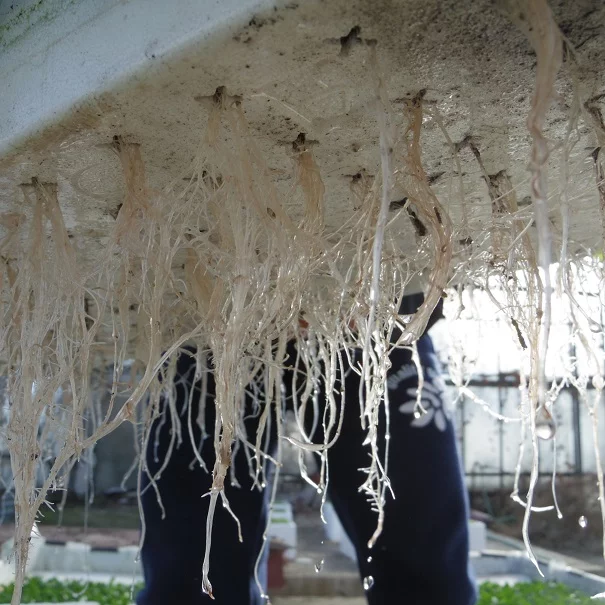Use of biostimulants in hydroponic culture
By: Athanasios Koukounaras, Filippos Bantis, Papoui Eleni
Department of Horticulture, Aristotle University, 54124 Thessaloniki, Greece.
*Correspondence: thankou@agro.auth.gr

Nowadays the agricultural sector has to face major challenges such as climate change, food security, more efficient use of resources as well as logistical uncertainties in the market. Hydroponic cultivation addresses the above issues with a wide range of advantages such as increasing yields, use of unsuitable soils and expansion of cultivation area (greenhouse, vertical production, PFAL’s, urban agriculture), biofortified products, production planning, increased nutrient use efficiency, as well as the improvement of water management. Increasing demand for hydroponic systems is recorded in many sectors, especially in vegetable production. As a result, it is expected that the hydroponic sector will grow at a CAGR of 11.3% and reach a value of 17.9 billion $ up to 2026 from 9.5 billion $ in 2020 [1]. The abovementioned perspectives are also based on the increasing demand for modern technologies such as plant factories with artificial lighting (PFAL), floating systems, aquaponics, aeroponics etc
Hydroponic systems can be classified based on the use or no-use of substrate or based on the management of the nutrient solution. Regardless of the type of hydroponic system the absence of soil results in the critical need for an exclusively external supply of nutrients. However, the cost and environmental impact of their use requires optimum management practices to increase the nutrient use efficiency by the crops. Plant biostimulants could be a valuable tool for improving crop production in hydroponics.

Figure 1. Hydroponic cultivation with rockwool
Since hydroponic systems are mainly established in protected environments (i.e. greenhouse, PFAL) foliar application of biostimulants can be applied regardless of outdoors environmental conditions while crops show high uniformity in size. Moreover, in liquid hydroponic systems, biostimulants could be added directly in the nutrient solution.
Different categories of biostimulants can be used with positive results in hydroponic systems. The use of digestate as a promising biostimulant has been recently reported [2, 3], since it is rich in both organic matter and nutrients and can be easily applied in a floating system. The results demonstrated that adding biostimulants it is possible to reduce the needs of inorganic fertilizer without imposing a negative effect on the yield and quality of lettuce. Moreover, the preliminary results demonstrated a lower nitrate level in leaves with the use of digestate, which is encouraging for the growers to satisfy EC regulation 1258/2011 for the acceptable limit of nitrates in lettuce. Consideration should be given in pH adjustment, the optimum range of which is 6-7.2 for nutrients availability, as well as in the physicochemical characteristics of the digestate.

Figure 2. Root system of rocket grown in floating system
Protein hydrolysates is a major category of plant biostimulants based on protein sources derived by partial hydrolysis [4]. An important advantage is the option to be applied either as foliar sprays or in the nutrient solution. In a study with green butterhead and red crisphead lettuce grown in floating system, the application of a legume-derived protein hydrolysates biostimulant applied both in the foliage and in the nutrient solution boosted their yield while having a positive impact on plant physiology and quality parameters [5]. Similarly, the use of amino acids in the nutrient solution, even at reduced minerals concentration, enhanced the yield as well as improved the nutritional quality and safety, especially by reducing nitrates’ accumulation in the tissues [6, 7].
Moreover, the beneficial effect of plant biostimulants has been established also in classic hydroponic systems with substrate mainly for fruit vegetables’ production. In particular, two sweet yellow peppers grown in rock wool substrate under reduced concentration of nutrients (30% of standard solution), with the addition of four biostimulants, resulted in the increase of yield and the improvement of their nutritional quality in terms of antioxidant activity, vitamin C and phenolic contents in fruits [8]. In another study involving hydroponically cultivated tomato under salt stress, a combination of amino acids inhibited the negative effects of salinity due to an increased accumulation of total soluble sugars [9].
In addition, Plant Growth-Promoting Rhizobacteria (PGPR) is a very attractive category of microbial biostimulants, which enhance nutrient uptake and increase important quantitative and qualitative parameters of the crops (i.e., yield, quality), as well as improve their tolerance to abiotic stress factors [10]. Even though the study of PGPR application is mainly focused under soil conditions, a few trials in hydroponic systems showed an increase of yield for a number of vegetables (tomato, cucumber, pepper) with the use of bacteria from the genus Pseudomonas and Bacillus [11-13].
A major concern in EU is the reduced consumption of fruits and vegetables, below the suggested amounts by World Health Organization, even though several projects aim to encourage young people to improve their eating habits. Therefore, crop biofortification programs have been proposed as a tool for increasing the daily intake of health-promoting substances. A recent review [14] has reported many examples of successful biofortification in hydroponic systems, and a key point is the simultaneous application of biostimulants on the availability and interactions of nutrients in the nutrient solution
Overall, hydroponic systems are expected to be in the foreground of the agriculture sector, especially for vegetable production, as an environmentally friendly technology and a valuable tool in terms of food security. A major advantage of plant biostimulants’ application in hydroponic systems is the flexibility for application either in the nutrient solution or as a foliar spray, which minimizes the cost; it is a simple procedure that allows to reduce nutrient concentration in the solution and enhance the yield with improved quality characteristics. However, further studies are required to clarify the optimum manner of biostimulants’ use in hydroponic systems (type, dose, application form, etc.) for enhancing crop performances in different growing conditions.
1. https://www.marketsandmarkets.com/Market-Reports/hydroponic-market-94055021.html
2. Guilayn F., Benbrahim M., Rouez M., Crest M., Patureau D., Jimenez J., 2020. Humic-like substances extracted from different digestates: First trials of lettuce biostimulation in hydroponic culture. Waste Management 114, 239-245.
3. Ntinas G.K., Bantis F., Koukounaras A., Kougias P.G., 2021. Exploitation of liquid digestate as the sole nutrient source for floating hydroponic cultivation of baby lettuce (Lactuca sativa) in greenhouses. Energies 14, 7199.
4. Colla, G., Rouphael, Y., Lucini, L., Canaguier, R., Stefanoni, W., Fiorillo, A. and Cardarelli, M., 2016. Protein hydrolysate-based biostimulants: origin, biological activity and application methods. Acta Hortic. 1148, 27-34.
5. Cristofano F., El-Nakhel C., Pannico A., Giordano M., Colla G., Rouphael Y., 2021. Foliar and rootyield and qualitative attributes of two lettuce cultivars grown in floating system. Agronomy 11, 1194.
6. Vernieri P., Borghesi E., Ferrante A., Magnani G., 2005. Application of biostimulants in floating system for improving rocket quality. Journal of Food, Agriculture & Environment 3, 86-88.
7. Tsouvaltzis P., Kasampalis D.S., Aktsoglou D.-C., Barbayiannis N., Siomos A.S., 2020. Effect of reduced nitrogen and supplemented amino acids nutrient solution on the nutritional quality of baby green and red lettuce grown in a floating system. Agronomy 10, 922.
8. Paradikovic N., Vinkovic T., Vinkovic-Vrcek I., Zuntar I., Bojic M., Medic-SariC M., 2011. Effect of natural biostimulants on yield and nutritional quality: an example of sweet yellow pepper (Capsicum annuum L.) plants. Journal of Science, Food and Agriculture 91, 2146–2152.
9. Alfosea-Simóna M., Zavala-Gonzalez E.A., Camara-Zapata J.M., Martínez-Nicolas J.J., Simon I., Simon-Grao S., Garcia-Sanchez F., 2020. Effect of foliar application of amino acids on the salinity tolerance of tomato plants cultivated under hydroponic system. Scientia Horticulturae 272, 109509.
10. Vasseur-Coronado M., du Boulois H.D., Pertot I., Puopolo G., 2021. Selection of plant growth promoting rhizobacteria sharing suitable features to be commercially developed as biostimulant products. Microbiological Research 245, 126672.
11. Gul A., Ozaktan H., Kıdoglu F., Tuzel Y., 2013. Rhizobacteria promoted yield of cucumber plants grown in perlite under Fusarium wilt stress. Scientia Horticulturae 153, 22-25.
12. Gul A., Ozaktan H., Yolageldi L., Cakir B., Sahin M., Akat S., 2012. Effect of rhizobacteria on yield of hydroponically grown tomato plants. Acta Hortic. 952, 777-784.
13. García J.A.L., Probanza A., Ramos B., Palomino M.R., Gutiérrez Manero F.J., 2004. Effect of inoculation of Bacillus licheniformis on tomato and pepper. Agronomie 24, 169–176.
14. Sambo P., Nicoletto C., Giro A., Pii Y., Valentinuzzi F., Mimmo T., Lugli P., Orzes G., Mazzetto F., Astolfi S., Terzano R., Cesco S., 2019. Hydroponic Solutions for Soilless Production Systems: Issues and Opportunities in a Smart Agriculture Perspective. Front. Plant Sci. 10, 923.



